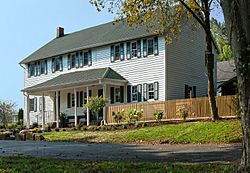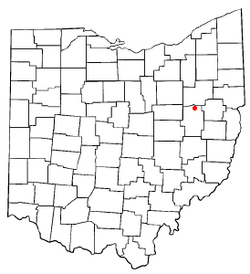Zoar, Ohio facts for kids
Quick facts for kids
Zoar, Ohio
|
|
|---|---|
|
Village
|
|

Former canal tavern
|
|

Location of Zoar, Ohio
|
|

Detailed map of Zoar
|
|
| Country | United States |
| State | Ohio |
| County | Tuscarawas |
| Township | Lawrence |
| Area | |
| • Total | 0.67 sq mi (1.72 km2) |
| • Land | 0.58 sq mi (1.49 km2) |
| • Water | 0.09 sq mi (0.23 km2) |
| Elevation | 896 ft (273 m) |
| Population
(2020)
|
|
| • Total | 172 |
| • Density | 298.61/sq mi (115.36/km2) |
| Time zone | UTC-5 (Eastern (EST)) |
| • Summer (DST) | UTC-4 (EDT) |
| ZIP code |
44697
|
| Area code(s) | 330 |
| FIPS code | 39-88168 |
| GNIS feature ID | 2399758 |
Zoar is a small village in Tuscarawas County, Ohio, United States. In 2020, about 172 people lived there. It was started in 1817 by a group of religious people called Radical Pietists. They wanted to create a special Christian community where everyone shared everything. This community lasted until 1898.
Many of the village's original buildings and its early design are still there today. Most of Zoar was added to the National Register of Historic Places in 1969. It was also named a National Historic Landmark District in 2016. Some of the old buildings are now museums you can visit.
Contents
History of Zoar Village
Zoar was founded in 1817 by Christian people from Germany. They were called the Society of Separatists of Zoar. They named their new home after a Biblical village where Lot and his family found safety.
Zoar was a communal society. This means that everyone in the village owned property together. Farms, shops, and factories were managed by leaders chosen by the community. The village became very successful in the 1850s. At that time, they owned over 10,000 acres of land. They were worth about $1 million, which was a lot of money back then.
Many of the buildings were built in a German style. They have been restored and are now part of the Zoar Village State Memorial. There are ten restored buildings you can see. The Ohio Historical Connection says Zoar feels like a piece of the "Old World" in Ohio.
Why the Separatists Came to Zoar
These Radical Pietists, also known as Separatists or Zoarites, came from a part of Germany called Württemberg. They faced religious problems from the Lutheran church there. Their beliefs were partly based on the writings of Jakob Böhme. They did not practice baptism or confirmation. They also did not celebrate most religious holidays, except for the Sabbath.
The village has a central flower garden designed to represent ideas from the Book of Revelation. It once had a tall tree in the middle, which stood for Christ. Other parts of the garden represented different symbolic ideas.
Joseph Bimeler, the Leader
The leader of the Zoar society was Joseph Bimeler (born 1778). He was a pipemaker and a teacher from Ulm, Germany. His strong leadership helped the village through many tough times. Bimeler led the society until he passed away in 1853.
Building the Ohio and Erie Canal
An important event for Zoar's success was the building of the Ohio and Erie Canal. The Zoarites had bought 5,500 acres of land without seeing it first. They used loans to pay for it, which they needed to pay back by 1830. For many years, the Society struggled to find ways to earn money to pay off these loans.
The state of Ohio needed some of Zoar's land for the canal. They offered the Zoarites a chance to help dig the canal for money. The Zoarites chose to dig it themselves. They spent several years in the 1820s working on the canal. This work helped them pay off their loans on time and even have extra money.
The End of the Communal Society
After Joseph Bimeler died on August 31, 1853, the village slowly started to lose its strong community spirit. By 1898, the villagers voted to end their communal society. The land and property were then divided among the people who still lived there.
Zoar's Location
Zoar is located along the Tuscarawas River. It is about 2.9 miles east of I77 using Ohio route 212. It is also about 16.1 miles south of Canton, Ohio.
According to the United States Census Bureau, the village covers about 0.67 square miles. Most of this area is land, and a small part is water.
Population of Zoar
| Historical population | |||
|---|---|---|---|
| Census | Pop. | %± | |
| 1850 | 249 | — | |
| 1860 | 252 | 1.2% | |
| 1870 | 326 | 29.4% | |
| 1880 | 291 | −10.7% | |
| 1900 | 290 | — | |
| 1910 | 182 | −37.2% | |
| 1920 | 178 | −2.2% | |
| 1930 | 146 | −18.0% | |
| 1940 | 208 | 42.5% | |
| 1950 | 200 | −3.8% | |
| 1960 | 191 | −4.5% | |
| 1970 | 228 | 19.4% | |
| 1980 | 264 | 15.8% | |
| 1990 | 177 | −33.0% | |
| 2000 | 193 | 9.0% | |
| 2010 | 169 | −12.4% | |
| 2020 | 172 | 1.8% | |
| U.S. Decennial Census | |||
Zoar in 2010
In 2010, there were 169 people living in Zoar. These people lived in 77 households, and 58 of those were families. The village had about 291 people per square mile.
Most of the people (98.2%) were White. About 19.5% of households had children under 18. The average age in the village was 52.6 years old.
Protecting Zoar from Floods
The village of Zoar faces a threat from flooding. A levee (a wall built to prevent floods) along the Tuscarawas River protects the village. This levee was built in 1936. However, it was given a very low safety rating by the U.S. Army Corps of Engineers.
Saving the Village
Because the levee was in bad condition, the Corps of Engineers looked at different solutions. They considered fixing the levee, buying the village and tearing it down, or moving the village to higher ground.
The Zoar Village Government and the Zoar Community Association worked hard to save the village. They created the "Save Historic Zoar Association." In 2012, the National Trust for Historic Preservation listed Zoar as one of "America's eleven most endangered historic places."
By 2013, the Corps of Engineers improved the levee's safety rating. They also decided not to consider tearing down the village. Instead, they focused on repairing the existing levee. This greatly reduced the chance that the village would need to be destroyed or moved.
Finally, in 2023, the Army Corps of Engineers finished a $14 million project. This project successfully repaired the levee and helped save Zoar Village from flood threats.
How Zoar Made Money
When the settlers first came from Germany, they needed help to pay for their journey and their new land in Ohio. Quakers from Great Britain and Philadelphia helped them. The Quakers shared similar beliefs, like being peaceful and practicing the Christian religion.
In 1817, the settlers bought about 5,500 acres of land. The Quakers loaned them money for part of the purchase. Joseph Bimeler promised to pay off the remaining $15,000 within 15 years.
In its early years, the community struggled to make money. The leaders even asked residents to not marry or have children for a while. This was because having many children would cost too much for the communal society.
Success with the Canal
When the Ohio and Erie Canal was being built in the 1830s, the Zoarites helped construct part of it. They earned $21,000 from the state for this work. During this time, their blacksmith and tin shops were doing well. They also had successful flour and wool mills.
By 1853, when Joseph Bimeler died, the village was worth about $5 million. This was the peak of their success. After 1853, the village began to decline. When the society ended in 1898, there were 222 members. The community was still worth an estimated $3.5 million.
Important Buildings in Zoar
When the village was built, the buildings were numbered in the order they were finished. Many of these original buildings are still standing today.
Number One House
This building was constructed in 1835. It was first meant to house the village elders. Joseph Bimeler and his family also lived here. It was sometimes called the "King's Palace."
Town Hall
The town hall for the Society was built in 1887. Since the Society ended in 1898, this building was one of the last ones they constructed. The town hall was restored in 2002 with money from private donations. The bottom floor is used for government meetings. The two upper floors display old items that were used in the village.
The Zoar Hotel
The Zoar Hotel was built in 1833. It was known as a place where anyone, rich or poor, could stay. President William McKinley especially liked staying here and enjoyed the German food. Today, the hotel is only open for special events. The outside of the hotel has been fixed up. However, the inside needs more work to be safe for regular visitors. The preservation group, Zoar Community Association, is looking for money to renovate the inside.
See also
 In Spanish: Zoar (Ohio) para niños
In Spanish: Zoar (Ohio) para niños



